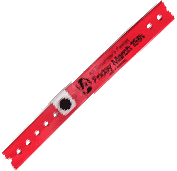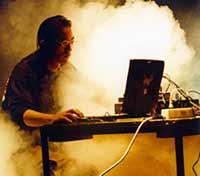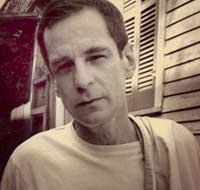All Tomorrow’s Parties. Los Angeles, 2002.
For the inaugural American version of the British music festival All Tomorrow’s Parties (ATP), “curators” Sonic Youth gathered together a wide assortment of musicians for a weekend of adventuresome music-making (March 14–March 17, 2002). From 1970s downtown New York rockers  Television to Japanese noise guru Merzbow, the festival’s offerings explored an array of non-mainstream popular musics grown from Rock and Hip-Hop’s possibilities. Originally scheduled for October 2001, the events of September 11th pushed the festival back into 2002. Yet organizer Barry Hogan and David Sefton of UCLA Performing Arts managed to reschedule and keep the lineup virtually intact, an impressive logistical feat. Some of the replacements held the eerie feeling of interchangeability worthy of Adorno’s attacks on the culture industry (feminist beat-box loudmouth Peaches for feminist beat-box terrors Le Tigre), but many of the core, big draw performers—Sonic Youth, Stereolab, Cat Power, Wilco—remained on the bill.
Television to Japanese noise guru Merzbow, the festival’s offerings explored an array of non-mainstream popular musics grown from Rock and Hip-Hop’s possibilities. Originally scheduled for October 2001, the events of September 11th pushed the festival back into 2002. Yet organizer Barry Hogan and David Sefton of UCLA Performing Arts managed to reschedule and keep the lineup virtually intact, an impressive logistical feat. Some of the replacements held the eerie feeling of interchangeability worthy of Adorno’s attacks on the culture industry (feminist beat-box loudmouth Peaches for feminist beat-box terrors Le Tigre), but many of the core, big draw performers—Sonic Youth, Stereolab, Cat Power, Wilco—remained on the bill.
The organizers clearly envisioned the event as more than just an esoteric Ozzy Osbourne’s “Ozzfest,” indicated by the choice of the title “curator” for Sonic Youth—who were essentially the event’s artistic directors. The sheer length of the festival allowed an in-depth exploration of each of the genres presented, enabling ATP to avoid the shallow eclecticism of many festivals. Using “curators” to describe Sonic Youth’s role distanced the event from the world of classical music, shifting it into upscale museum culture. Historian William Weber has shown how an active distrust of new music developed in (what we now would call) “classical” music culture in the late 19th century (Weber 20). Yet, I would think that classical music’s relationship to the static, reified world of the musical museum—inherently resistant to new sounds—would be a key element turning rock fans away from classical terms and techniques. The implications of “curator”—that Sonic Youth were providing a standing exhibition, something to be looked at, admired, and left as-is—clashed with the kind of musicking many of the bands engaged in during the weekend.
ATP spread itself out between three performance spaces on the UCLA campus. The main venues, the upscale Royce Hall and cavernous Ackerman Grand Ballroom, are a brisk five minute walk from each other, slightly problematic for concertgoers eager to jump from one band to the next. However, it was the uneven scheduling of bands that caused the majority of headaches and delays. One example: on Friday the planners placed Pearl Jam lead singer Eddie Vedder in Royce while Philadelphia based psych-rockers Bardo Pond played in Ackerman. Perhaps they hoped that attendees would spread themselves evenly between the two, but the long line outside Royce proved otherwise. This mismatch also reflected a surprising haughtiness towards and dismissal of the attendees’ musical horizons, manifested in a post-concert letter from Barry Hogan on the ATP website: “if anyone bought a ticket just to see one act then you totally didn’t understand what ATP was offering and you need your head checked.” During Vedder’s acoustic set, Bardo Pond played an enthralling forty-five minutes of psychedelia missed by many who wanted to see not just Vedder, but Royce’s next two acts, Cat Power and Television. The two-hour line served to further separate the performers from the audience that paid to see them.

Sleater-Kinney © 2002 John Clarke
On Saturday night, things seemed to go better, and many of the more popular acts—Cannibal Ox, Sleater-Kinney, Boredoms, Aphex Twin—were in Ackerman, a much more flexible performance space. Early in a set full of promising new songs, Sleater-Kinney’s Carrie Brownstein urged the audience to dance because “especially in times like this, getting together and dancing communally is a good thing.” Truthfully, this admonition felt a little redundant when the band proceeded to rip into a rendition of one of their earliest hits “Call the Doctor.” The members of Sleater-Kinney clearly agree with Christopher Small’s assertion that “music is not a thing at all but an activity, something that people do” (Small 2). For them, dancing—especially following September 11th and during the war in Afghanistan—belongs to the participatory activity of music, making ATP as much about the audience coming together as the specifics of performance. This concern for togetherness, audience participation, and good feelings was often obscured by another kind of musicking, which the audience also enjoyed and expected.

Merzbow in Concert © 2001 Avanto Festival
In contrast to Sleater-Kinney, Japanese noise-band Merzbow—actually one man, Masami Akita—played two Apple PowerBooks, and his entire bodily movement consisted of a slight rotation between the two screens and the occasional mouse click. Starting quietly with a structure of fuzzes and twitters, he gradually created a solid block of noise that obscured the individual layers of the sound in favor of a simple onslaught. Despite Akita’s appearance at the computers, this noise created an interactive musicking environment whereby Merzbow inflicted itself upon the audience—many of whom were slightly stunned Sleater-Kinney fans—with a twisted kind of mutual consent. When the set was over, all Akita had left to do was close his laptops, unplug them and walk away. His music’s attack on the eardrums was his only interaction with the audience. This was a contrast to dissonant Chicago rockers U.S. Maple the previous night, who constantly pushed at the “fourth wall” without succeeding to cross it. Their music communicates a craving for an always unfulfilled, frankly sexual climax, but their live show frustrated these desires by constantly stepping away from what this suggests. In other words, they shied away from these implications and replaced them with hollow aggression directed at the audience.1
Earlier in the evening and across campus, 1970s punk-remainders-turned-experimental-rock-stalwarts Destroy All Monsters played an entirely different kind of noise-set. The four-man band set the stage with a variety of homemade instruments, many of which appeared to be fashioned from parts of the same mannequin. They played a short set of dissonant extremes, using humor and whimsy to draw the audience. Destroy All Monsters created a riff into which they could enter and leave as easily as they picked up and dropped instruments. Originally from Detroit, the band ended with what I assume was the University of Michigan fight song—proclaiming Michigan’s ability to “kick some Bruin ass”—gleefully combined with Laurie Anderson (“O Superman!”), Steve Reich (Come Out), and Captain Beefheart (“Old Time Religion”). These inside jokes included the audience in the fun, making the cacophony of their creations a participatory endeavor. Their encore/finale was a performance of various squeak-toys at the front corner of the stage as confused stage hands removed the mannequin’s various parts. Destroy All Monsters’ ability to create reckless noise compositions while maintaining a wild sense of humor about the entire undertaking made their set especially enjoyable.
Whereas Sleater-Kinney and Merzbow both played in the echoing confines of Ackerman Grand Ballroom—a space without the seating that would have prevented fans from crowding the stage—Destroy All Monsters played in the grand Royce Hall, a professional performance space with comfortable seats and a fancy lighting system. The space lacked the easy intimacy almost guaranteed in Ackerman, and many audience members were relegated to the balcony by overzealous ushers. UCLA’s indoor settings imparted their own rules and conditions upon the music performed there, in a way quite different from the muddy field typical of many weekend long festivals. Royce’s professional ushers—with flashlights!—and perhaps an eager lighting technician conveyed a “now we’ve made it” atmosphere to the bands playing there, no matter how dissonant. In fact, most of ATP’s careful noise constructors—Jackie O Motherfucker, Kevin Drumm + Lee Rinaldo + Leah Singer, Ikue Mori + Kim Gordon + Jim O’Rourke—played in this upscale environment, which seemed somehow suited for their “difficult” music.
Outside the variety of “noise” artists, another dominant theme at ATP LA was the number of reunion sets from bands that have neither toured nor released albums in years. Television, The Stooges, Big Star, and the Minutemen all made appearances in one form or another, although both the Stooges and the Minutemen chose to go by other names (all four bands lacked a full “original” lineup). In this way Sonic Youth, one of the oldest and most influential bands at the concert and in rock today, opened the stage to pay tribute to the musicians that came before them. This reunion trend may have begun with the Sex Pistol’s tour in 1997, but its continued popularity points towards audiences’ and bands’ desires to relive past glories. And, as the Sex Pistols’ Johnny Rotten admitted, these concerts are a great way for some old farts to make some serious cash. On Friday night, Television played a greatest hits set full of long jams punctuated by complicated guitar-changing rituals. Independent of Royce’s distractions of lighting and long lines, it sounded pretty great. Hearing Television’s “See No Evil” in a live setting gave me tingles, but I couldn’t shake the feeling that I was watching a Television cover band featuring the original artists. The guitar changes were especially distracting and oddly finicky. Luckily the woman next to me would not allow the excessively formal atmosphere of Royce Hall deter her from her joint.

Alex Chilton circa 2000 © 2000 Bar None Records
The other “reunion” bands I saw over the weekend were somehow more successful than Television at recreating a certain vitality in their music. Big Star began their show in Royce with “In the Streets,” best known as the theme song of the sitcom “That 70’s Show.” Frontman Alex Chilton possessed an experienced ease and his decision to begin with a song currently popular in order to hook unsure listeners confirmed the band’s desire to share their music with as large an audience as possible. In a slightly different vein, Mike Watt’s Secondmen on Sunday night was another in Watt’s current cover band obsession (he often plays in a Stooges cover band in LA). The Secondmen primarily—but not exclusively—played music from his early 80s So-Cal punk band, The Minutemen. Seeing some homegrown talent in the middle of national and international acts was refreshing, and Watt remains a spectacular bass player—casual in his virtuosity. The Secondmen’s rendition of Television’s “Friction” showcased an interesting reinterpretation of the song’s bass lick. This was not the most amazing music I heard during the long weekend, but Watt and friends were clearly there to entertain and the audience responded enthusiastically.
Unfortunately for the Secondmen, they followed on the heels of Peaches, one of the most original and overwhelming acts of the entire festival. With songs dominated by one or two catchy lines—such as “Fuck the Pain Away”—a drum machine, overhead projector, and sheer force of will, Peaches exemplified feminist noise terror. She performed in front of an evolving canvas of entertaining and sexually explicit paintings created live by her collaborator Shary Boyle. Among highlights was Peaches shouting “I don’t give a fuck, I don’t give a shit,” above a sample of Joan Jett’s “I don’t give a damn about my reputation.” Peaches, who programs her drum backgrounds, engaged with the audience much like Sleater-Kinney, challenging them to sing along and dance. The subdued response was nonetheless more than turntablist Mad Lib and his crew got the night before.
One of the reasons it was so difficult for bands to get enthusiastic physical reactions from the audience may have been the age of the concert concertgoers. With the exception of Sleater-Kinney’s fan base, the average age of attendees seemed to be in their late 20s, early 30s. It seems weird to go to a rock show and see just one group of guys clearly under the age of eighteen, and few others younger than myself.2 Although individual day passes were available, a three-night pass was one-hundred dollars and the price just went up from there, a factor certainly keeping many younger people away. Much of the music represented at ATP can no longer be called “youth music” (although the kids certainly like some, if not most of it). Mike Watt’s cover bands do not attempt to bring the music of the early 80s to the youth of today, and the Strokes probably do a better job of creating listeners for Television’s old albums than Television itself. Yet popular music academics primarily discuss non-mainstream popular music—especially punk and hip-hop—in the terms and assumptions of youth culture.
The final night, which included the Secondmen and Peaches, ended with a double-whammy of independent rock super stars, Stereolab and “curators” Sonic Youth. Stereolab carefully assembled their standard multi-layered songs, the best of which created a hypnotic sense of time-standing-still. The crowd was pleased. Sonic Youth also took the stage confidently, performing a set spanning their own peculiar range of musics. They played several new songs, neither good nor interesting, that served to frame virtuosic noise breakouts—they also used older, better songs for the same purpose. One highlight of the show was from a recent release “Goodbye Twentieth Century,” where the band constructs a noisescape worthy of their best efforts (although perhaps not at its best in the caverns of Ackerman). Repeatedly bending into their instruments to pull out complexes of sounds both amorphous and firmly rooted in their song material, Sonic Youth left Stereolab and many of the weekend’s other performers in the dust.
Despite its museum demeanor, ATP was essentially a music festival like any other, its length allowing the audience to explore in depth many of the different musical threads that permeated the concert atmosphere. Many that I talked to in the audience came with a specific series of events to attend, successfully constructing their own music festival from Sonic Youth’s selections. Most also demonstrated flexibility and foresight after the disappointments of Friday night, realizing that they would not be able to check out all the bands at ATP. Music festivals are odd birds, often too expensive for the youngsters who still have the stamina to last through the long hours of music and waiting, music and waiting. In Los Angeles, it can often be hard to get to one (eight dollar!) show on a Friday night, and having all these great bands come out and share their music in one place was a treat well worth the price. By the end of Sonic Youth’s performance on Sunday night—heck, two minutes into Peaches’ performance on Sunday night—my faith in live music was as strong as it’s been since Lollapalooza 2.
***
Caroline O’Meara is a graduate student in the Department of Musicology at the University of California, Los Angeles. She received her BA summa cum laude in music from Princeton University in 1998. Her primary scholarly interest is the field of popular music studies, including the influence of feminism on punk rock and the ways noise can be understood in rock. She recently presented a paper on Bikini Kill at UCLA’s “Thinking Gender” conference.
***
Works Cited
“All Tomorrow’s Parties: LA 2002.” All Tomorrow’s Parties–LA 2002. 12 April 2002. <http://www.wayahead.com/atp/sy2001.htm>. (No longer online).
Small, Christopher. Musicking: The Meanings of Performing and Listening. Hanover and London: UP of New England, 1998.
Weber, William. “Mass Culture and the Reshaping of European Taste, 1770–1870.” International Review of the Aesthetics and Sociology of Music 8.1 (1997): 5–21.
